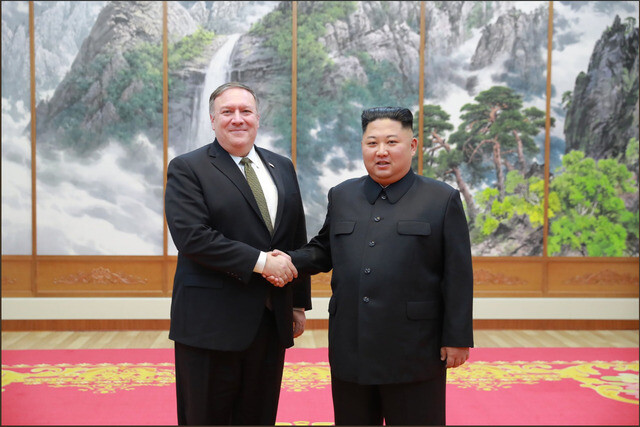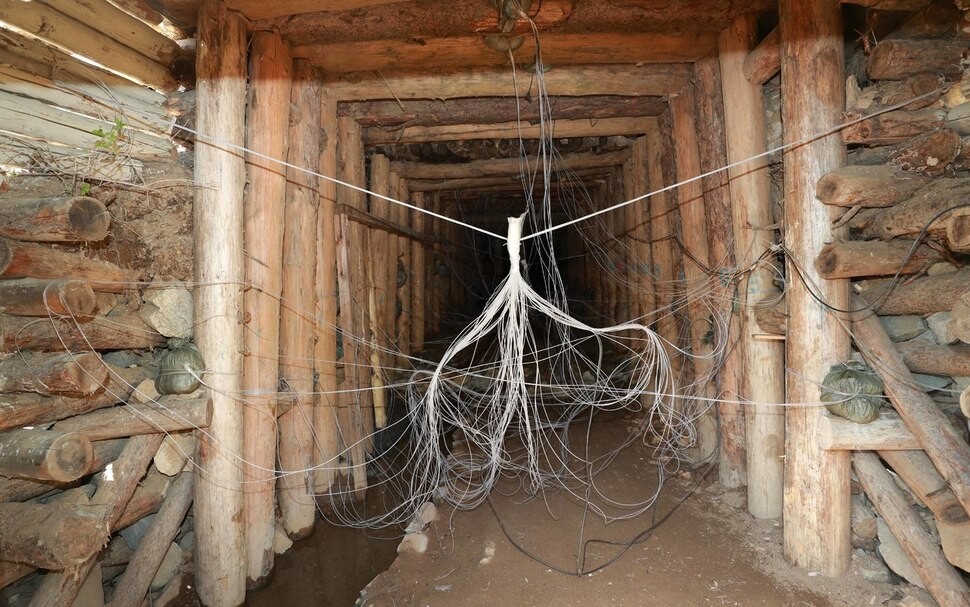hankyoreh
Links to other country sites 다른 나라 사이트 링크
Kim Jong-un invited team of inspectors to confirm shutdown of Punggye Village test site

North Korean leader Kim Jong-un invited a team of inspectors to confirm that the nuclear test site at Punggye Village, Kilju County, North Hamgyong Province, had been irreversibly dismantled, the US State Department announced on Oct. 7.
On May 24, North Korea invited reporters from five countries (South Korea, the US, China, the UK and Russia) to Punggye Village to attend the demolition and dismantlement of the nuclear test site located there, but there was criticism from conservatives in South Korea and the US that this was a charade and a fraud.
The basis of this criticism was that no experts from the US or the International Atomic Energy Agency (IAEA) were present to verify the proceedings. The State Department’s announcement means that Kim Jong-un promised during his meeting with US Secretary of State Mike Pompeo in Pyongyang on Oct. 7 that North Korea would take measures to enable US government experts to visit Punggye Village to observe (or “verify,” to use the American term) that North Korea’s only nuclear test site has been permanently (or “irreversibly”) shut down.
Kim’s efforts to build trust about denuclearization are important for two reasons. First, this is the first chance to assess trustworthiness on the long journey toward the “complete denuclearization” of the Korean Peninsula, and it could also be the starting point down the path toward the inspection and verification of other nuclear weapons and facilities.
Second, this is taken as a sign that the deliberations during Pompeo’s fourth visit to North Korea have altered the denuclearization methodology of the Trump administration, which has been demanding that North Korea submit a list of its nuclear facilities as the first stage of negotiations. This is also consistent with the September Pyongyang Joint Declaration, in which Kim and South Korean President Moon Jae-in proposed a denuclearization process focused on concrete action (and verification) at sites including Tongchang Village and Yongbyon without mentioning the submission of a nuclear inventory.
Kim and Moon reiterated their pledge to make the Korean Peninsula “free from nuclear weapons” while laying out an initial roadmap for denuclearization, including unilateral good-faith measures (“the North will permanently dismantle the Tongchang Village missile engine test site and launch platform under the observation of experts from relevant countries”) and additional measures with strings attached (“the permanent dismantlement of the nuclear facilities in Yongbyon, as the United States takes corresponding measures in accordance with the spirit of the June 12 US-DPRK Joint Statement”).

In connection with this, Pompeo has made no mention of North Korea submitting a nuclear inventory before or during his tour of the four countries of Japan, North Korea, South Korea and China. Nor did a nuclear list appear in the press release that US State Department Spokesperson Heather Nauert released about the results of Pompeo’s visit to Pyongyang. This is a notable change.
“Chairman Kim invited inspectors to visit the Punggye Ri [Village] nuclear test site to confirm that it has been irrevocably dismantled,” Nauert wrote in the press release. “Pompeo held productive discussions with Chairman Kim Jong-un in Pyongyang Sunday. They discussed the four elements contained in the US-DPRK Singapore Summit Joint Statement signed by President Trump and Chairman Kim.”
The June 12 joint statement detailed the establishment of new relations between North Korea and the US, a permanent and stable peace regime on the Korean Peninsula, the complete denuclearization of the Korean Peninsula, and the recovery and repatriation of POW and MIA remains from the Korean War.
The plan to invite a team of US experts to the dismantled nuclear test site at Punggye Village is thought to be one of the items discussed in connection with denuclearization but not included in the statement, as mentioned in Moon’s briefing to the public after he returned to South Korea following his summit with Kim on Sept. 20.
In relation to this, Pompeo was asked when the shutdown of the Punggye Village nuclear test site would be verified while speaking with a pool of reporters at the Grand Hyatt Hotel in Seoul before he departed for China on the morning of Oct. 8. “Chairman Kim said he’s ready to [. . .] as soon as we get it logistically worked out,” Pompeo responded.
“When you combine the commitments that came out of the joint statement between the North and South [. . .] from the Pyongyang summit as well as the issues that Secretary of State Pompeo and Chairman Kim discussed yesterday, we’re starting to see a first wave of actions we can take on [. . .] the Singapore communique, [. . . and] specifically on the issue of denuclearization,” Special Representative for North Korea Stephen Biegun said on the same occasion.
This shows that North Korea and the US have skirted the major obstacle of insisting that the nuclear inventory be submitted first and started taking the first steps toward denuclearization.
Some figures in the diplomatic community suggest that if North Korea and the US agreed to the verification of the dismantlement of the Punggye Village nuclear test site, they most likely also discussed the permanent dismantlement of “the Tongchang Village missile engine test site and launch platform under the observation of experts from relevant countries,” as Kim promised in the Pyongyang Declaration. When asked about the facility at Tongchang Village, Pompeo said he also expects that to be dismantled under observation as well.

Remaining lack of clarity of US’ corresponding measures for shutdown of Yongbyon
The problem is what happens after that. According to the Pyongyang Declaration, the “permanent dismantlement” of the Yongbyon nuclear facility – which is the nexus and symbol of North Korea’s nuclear capability – is contingent on “the United States [taking] corresponding measures in accordance with the spirit of the June 12 US-DPRK Joint Statement.”
But it remains unclear what Kim and Pompeo discussed and what agreements they may have reached in connection with this, as well as a proposed declaration that would formally end the Korean War. Neither North Korea nor the US have been forthcoming about these questions.
“During his meeting with Mike Pompeo, Kim Jong-un probably explained his vision of the roadmap for denuclearization and the normalization of North Korea-US relations by the end of President Trump’s first term in office [in Jan. 2021]. A concrete agreement will probably be made during the second North Korea-US summit,” a diplomatic source said.
In the end, the final decision about the “corresponding measure” that the US needs to give North Korea will probably be made during Kim and Trump’s second summit, after the two sides have ironed out the roadmap and the details of denuclearization in working-level negotiations.
“[Secretary Pompeo] had a good meeting with Chairman Kim today in Pyongyang. Progress made on Singapore Summit Agreements! I look forward to seeing Chairman Kim again, in the near future,” Trump wrote on Twitter on Oct. 7.
By Hwang Joon-bum, Washington correspondent, and Lee Je-hun, senior staff writer
Please direct comments or questions to [english@hani.co.kr]

Editorial・opinion
![[Guest essay] The real reason Korea’s new right wants to dub Rhee a founding father [Guest essay] The real reason Korea’s new right wants to dub Rhee a founding father](https://flexible.img.hani.co.kr/flexible/normal/500/300/imgdb/original/2024/0423/8317138574257878.jpg) [Guest essay] The real reason Korea’s new right wants to dub Rhee a founding father
[Guest essay] The real reason Korea’s new right wants to dub Rhee a founding father![[Column] ‘Choson’: Is it time we start referring to N. Korea in its own terms? [Column] ‘Choson’: Is it time we start referring to N. Korea in its own terms?](https://flexible.img.hani.co.kr/flexible/normal/500/300/imgdb/original/2024/0423/3617138579390322.jpg) [Column] ‘Choson’: Is it time we start referring to N. Korea in its own terms?
[Column] ‘Choson’: Is it time we start referring to N. Korea in its own terms?- [Editorial] Japan’s rewriting of history with Korea has gone too far
- [Column] The president’s questionable capacity for dialogue
- [Column] Are chaebol firms just pizza pies for families to divvy up as they please?
- [Column] Has Korea, too, crossed the Rubicon on China?
- [Correspondent’s column] In Japan’s alliance with US, echoes of its past alliances with UK
- [Editorial] Does Yoon think the Korean public is wrong?
- [Editorial] As it bolsters its alliance with US, Japan must be accountable for past
- [Guest essay] Amending the Constitution is Yoon’s key to leaving office in public’s good graces
Most viewed articles
- 1Senior doctors cut hours, prepare to resign as government refuses to scrap medical reform plan
- 2[Column] ‘Choson’: Is it time we start referring to N. Korea in its own terms?
- 3Why Korea shouldn’t welcome Japan’s newly beefed up defense cooperation with US
- 4Opposition calls Yoon’s chief of staff appointment a ‘slap in the face’
- 5[Guest essay] The real reason Korea’s new right wants to dub Rhee a founding father
- 6[Editorial] Japan’s rewriting of history with Korea has gone too far
- 7New AI-based translation tools make their way into everyday life in Korea
- 8[Column] The clock is ticking for Korea’s first lady
- 9[Column] Has Korea, too, crossed the Rubicon on China?
- 10Terry Anderson, AP reporter who informed world of massacre in Gwangju, dies at 76